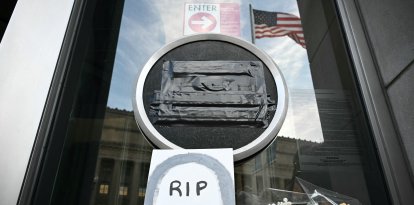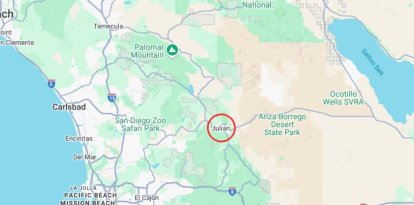The disturbing details behind the Epstein case: What did the pedophile's safe contain that the FBI “lost”?
Lost evidence, favorable treatment and a suicide under strange circumstances bring the controversial case back into the limelight after a series of documents were published that, in reality, do not contain many new details.

(Cordon Press)
The year was 2008. A powerful tycoon, strongly connected to the political and cultural elite, not just in the U.S. but worldwide, is accused of sex trafficking in Florida, leading to a scandal whose repercussions continue to this day. This is a case with many irregularities and unexplained situations that has generated an ideal breeding ground for speculation. This is the full story of the dark details of the Jeffrey Epstein case and the questions that have remained unresolved despite unredacted court documents released last Wednesday.
Why did Epstein obtain a favorable agreement from the Prosecutor’s Office in 2008?
It all began in 2005 when the family of a 14-year-old girl reported to the Police that Epstein sexually abused the minor in his mansion in Palm Beach.
The police in Palm Beach began to investigate Epstein and, at the same time, several new minor complainants emerged who told the authorities that the magnate hired them to give “massages,” a euphemism for sexual relations.
Palm Beach Police decided to charge Epstein with multiple counts of unlawful sexual relations with minors and signed all relevant documentation. This is where the first irregularity begins.
Barry Krischer, the former Palm Beach State Attorney, considered, based on his legal decisions, that Epstein’s first victims were prostitutes. Therefore, he made the unusual and controversial decision of sending the case to a grand jury.
In 2006, the mogul was finally arrested after the grand jury determined that the first criminal charge against Jeffrey Epstein was soliciting a prostitute.
That relatively minor charge came after the testimony of a 14-year-old who dared to testify before the grand jury in 2006. She was the only victim who dared to testify.
That first charge aroused strong criticism against Krischer, especially among police leaders, which is why the FBI entered the case and the name of former prosecutor Alexander Acosta emerged, who got a job in the Trump Administration a year later.
In 2007, as federal prosecutors were preparing an indictment against Epstein, the mogul’s lawyers got their controversial client a state plea deal after arguing that the witnesses blaming their client were unreliable.
Then, in 2008, Epstein was sentenced to 18 months in prison and had his name placed on the U.S. sex offender registry under a secret agreement whose details were not revealed at the time. In the end, the tycoon only spent 13 months behind bars.
In addition to avoiding federal charges, Epstein managed to spend most of his sentence under a probation regime that allowed him to leave prison during the day to go to his office and then return to jail at night.
The controversial case gained national attention, and a decade later, in 2018, it was discovered that Epstein became an FBI informant. Thanks to this, he achieved his favorable agreement that also exonerated potential accomplices. The Miami Herald accessed a trove of unpublished documents related to Epstein’s controversial deal with the federal agency and detailed the situation in an extensive report.
The Florida newspaper also mentioned that the information that Epstein gave to the FBI was not revealed. That is, everything the controversial hedge fund manager said to the Government was not revealed to the public.
“The Herald learned that, as part of the plea deal, Epstein provided what the government called “valuable consideration” for unspecified information he supplied to federal investigators. While the documents obtained by the Herald don’t detail what the information was, Epstein’s sex crime case happened just as the country’s subprime mortgage market collapsed, ushering in the 2008 global crisis,” the article reads.
Arrest and suicide in 2019: What happened to Epstein’s safe?
After walking free in 2009, a decade later, Epstein was finally arrested in New York on federal sex trafficking charges.
The 2019 official indictment says that the magnate, between 2002 and 2005, “sexually exploited and abused dozens of underage girls by enticing them to engage in sex acts with him in exchange for money.”
In the interim, several extremely important things happened. Journalist Conservative Mike Cernovich filed a lawsuit to have the hidden documents of the case released; the Miami Herald joined this process, and, in this way, the public obtained details about the magnate’s crimes after intense pressure from the public brought against the Department of Justice.
Following the 2019 arrest, FBI agents raided Epstein’s New York mansion at 9 East 71st Street between July 6 and 7.
Federal agents found “a vast trove of lewd photographs” of young girls, including photographs of “at least one girl, who, according to her counsel, was underage at the time the relevant photographs were taken.”
As a critical piece of information, the agents discovered “in a locked safe … compact discs with hand-written labels including the following: ‘Young [Name] + [Name],’ ‘Misc nudes 1,’ and ‘Girl pics nudes.’”
This safe, according to the British newspaper The Telegraph, “went missing.” Many critics say that these tapes were extortion materials that Epstein had in his possession to persuade or subdue his “powerful” clients, such as politicians, royalty or celebrities.
In 2021, Kelly Maguire, a special agent, testified during the trial of Ghislaine Maxwell, Epstein’s lover and partner in crime, that the evidence from the safe was lost because the FBI did not have the warrant in the first place to retain the findings.
According to Maguire, the FBI took photographs of the items, but they were left at the residence and when they returned to the raided location four days later, on July 11, they were no longer there.
Maguire, who served on an FBI Child Exploitation and Human Trafficking Task Force, said she spoke by phone with Richard Kahn, Epstein’s attorney, who brought the items back in two suitcases but could not verify whether they were the same.
Cernovich, the journalist who filed the lawsuit so that the public could obtain details about the Epstein case, posted on X (formerly Twitter) that the evidence from that safe was the most important in the case, and it will never be known exactly what was inside beyond mere speculation.
From that point forward, everyone knows what happened: Epstein was arrested on July 6 in New Jersey and committed suicide, according to the official version, on August 10, in a federal prison at the Metropolitan Correctional Center (MCC) in Manhattan after pleading innocent to all sex trafficking charges and after thousands of documents about his crimes came to light.
Some experts, such as Dr. Michael Baden, argue that Epstein’s injuries are unusual in a suicide hanging case after examining the autopsy of the disgraced tycoon. There is also no audiovisual evidence of the suicide since the cell cameras were out of service and his roommate was changed before the event.
“Going over a thousand jail hangings, suicides in the New York City state prisons over the past 40-50 years, no one had three fractures,” Baden told 60 Minutes.
All the details of the magnate’s death, added to the irregularities of the investigation, only generated more speculation about his dark business of trafficking minors and who was involved.
The case is now back in the limelight after the names in the lawsuit filed in 2015 by Virginia Giuffre against Maxwell were revealed last Wednesday. That lawsuit was settled privately between Epstein’s victim and the pedophile’s girlfriend.
However, despite the global commotion, the documents do not reveal many new details about the case, serving as a nest of misinformation and causing us to lose sight of all the irregularities that occurred in the process and have left the victims, at least currently, without justice.
RECOMMENDATION





















